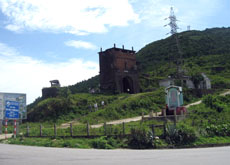Khai Don saddles a two-wheeled horse and braves the steep winding roads of a paved mountain pass, discovering peace, quiet and history along the way.

The 21 km that stretch over the Hai Van mountain pass may sound like a challenging journey, but after having done it myself I can tell you – it’s one worth taking.
I decided to attack the pass by bicycle, as the paved road makes it an attractive option. While the road allows a smooth ride, I can assure you that at this angle up the mountain, it certainly is anything but easy.
What’s most impressive about this journey is the sense of isolation you feel as you move further along. There is a strange delight about the desolate conditions, a seemingly unbroken asphalt road that cuts through a mass of forest. Below you, the green trees contrast with the breaking waves in the blue sea. I took a break along the side of the road to rest my legs, and felt for that moment, in the isolation of the area, like I was the only creature on the planet.
And herein lays the beauty of Hai Van. While many rave about the charm of the Bao Loc mountain pass, the road is crowded with people and villages nestled along the way. But just as civilization characterizes the allure of Bao Loc, Hai Van’s beauty is closely connected to nature and its lack of population.
In my itinerary to Hai Van, I did find traces of abandoned camps, evidence that my solitary journey had been taken before. There were traces of tents used as make-shift car washes and water points.
There were also forgotten natural water taps which were left on, with their water flowing down the side of the mountain.
I stumbled across one of these forgotten taps. Fresh water spurted out into a line flowing down the mountain, and a smile came across my face as I sipped the ice-cold drink. In was an incredible thing to find such cool liquid running freely in the hot weather.
As I reached the peak, my green surroundings started to clear, and I could hear the bustle of human activity starting to grow out of silence. At the mountain’s foot I could see a leper’s hospital.
I was reaching the end of the road, which just barely clings to the mountainside, seemingly ready to drop deep into the abyss. Hai Van is well know for its dangerous roads, and accident warning boards carefully appear regularly along the side. As I made my way along the middle of the mountain pass, a whistle of a big lorry carrying oil tore through the quiet space as it climbed heavily up the mountain.
From the amazing desolate conditions of the base, I felt the buzz of activity grow upon me. It’s a surprising sight to see the animation and modernity at the peak as foreign visitors buzzed about buying souvenirs.
Those who don’t make it to the peak would have a hard time believing there was such a busy trading and modern scene, as foreign women made their way up the rough staircase at the Hai Van Quan ancient vestige to take photos.

The entrance to Hai Van Quan looks like the entrance to an old citadel with its stone structures. Time, war, and neglect have taken its toll on Hai Van Quan, as it sits today in near ruins.
Lining the peak of the mountain is the immense abyss dotted with the light and dark green colours of the trees. The scene is capped off with fanciful clouds flying across the sky.
The area is a perfect place to have a cup of coffee and contemplate the scene, looking over Hai Van as if from the heavens as the trees blow with the wind.
My impression of the virginal landscape was suddenly cut short, as I caught a glimpse of a cot belonging to one of Hai Van Quan’s watchmen. I tried to block it out and imagine a woeful and majestic time that used to be, but that page in history has been turned. Luckily the sky and sea here haven’t changed, and I rejoiced and prayed that this is one landscape that will hopefully remain intact.
My joy, however, disappeared, as my legs started to tremble from those 10 km on the road. I wasn’t looking forward to the trip back.